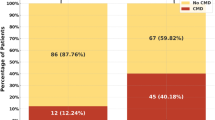Abstract
The present study evaluated the efficacy of intracoronary administration of verapamil to attenuate the no-reflow phenomenon following the primary percutaneous coronary intervention (PCI) in patients with the ST-segment elevation acute myocardial infarction (STEMI). A total of 201 patients with STEMI who underwent primary PCI within 12 h from the beginning of the heart attack were included. The no-reflow phenomenon was defined as substantial coronary anterograde flow of TIMI ≤2. Verapamil (100–200 μg) was injected into coronary artery immediately after no-reflow; the coronary arteriography was repeated later. Hundred and ninety-eight patients with STEMI successfully underwent primary PCI, and 246 stents were implanted with the average of 1.2 stents per patient. No-reflow occurred in 25 out of 198 patients (12.6 %). Twenty-one (84 %) patients developed the flow of TIMI ≥3 after intracoronary administration of verapamil, as revealed by repeated coronary angiography. Two patients developed transient hypotension which normalized without treatment within 3–5 min. Three patients showed sinus bradycardia, in one patient there was transient II sinoatrial block, and one patient developed type 1 atrioventricular block. All adverse effects were alleviated after intravenous injection of atropine (0.5–1 mg). In conclusion, the no-reflow phenomenon following primary PCI in patients with STEMI is significantly improved by intracoronary administration of verapamil which is useful to reduce cardiovascular events during operation.
Similar content being viewed by others

References
Isaaz, K., Robin, C., Cerisier, A., Lamaud, M., Richard, L., Da, C. A., et al. (2006). A new approach of primary angioplasty for ST-elevation acute myocardial infarction based on minimalist immediate mechanical intervention. Coronary Artery Disease, 17, 261–269.
Rezkalla, S. H., Dharmashankar, K. C., Abdalrahman, I. B., & Kloner, R. A. (2010). No-reflow phenomenon following percutaneous coronary intervention for acute myocardial infarction: incidence, outcome, and effect of pharmacologic therapy. Journal of Interventional Cardiology, 23, 429–436.
Lee, C. H., Wong, H. B., Tan, H. C., Zhang, J. J., Teo, S. G., Ong, H. Y., et al. (2005). Impact of reversibility of no reflow phenomenon on 30-day mortality following percutaneous revascularization for acute myocardial infarction-insights from a 1,328 patient registry. Journal of Interventional Cardiology, 18, 261–266.
Rezkalla, S. H., & Kloner, R. A. (2008). Coronary no-reflow phenomenon: from the experimental laboratory to the cardiac catheterization laboratory. Catheterization & Cardiovascular Interventions, 72, 950–957.
Chesebro, J. H., Knatterud, G., Roberts, R., Borer, J., Cohen, L. S., Dalen, J., et al. (1987). Thrombolysis in Myocardial Infarction (TIMI) Trial, Phase I: a comparison between intravenous tissue plasminogen activator and intravenous streptokinase. Clinical findings through hospital discharge. Circulation, 76, 142–154.
Kloner, R. A., Ganote, C. E., & Jennings, R. B. (1974). The “no-reflow” phenomenon after temporary coronary occlusion in the dog. The Journal of Clinical Investigation, 54, 1496–1508.
Ito, H., & Iwakura, K. (1998). Assessing the relation between coronary reflow and myocardial reflow. American Journal of Cardiology, 81, 8G–12G.
Villanueva, F. S. (2002). Myocardial contrast echocardiography in acute myocardial infarction. American Journal of Cardiology, 2002(90), 38J–47J.
Nakamura, S., Takehana, K., Sugiura, T., Hatada, K., Hamada, S., Asada, J., et al. (2003). Quantitative estimation of myocardial salvage after primary percutaneous transluminal coronary angioplasty in patients with angiographic no reflow. The European Journal of Nuclear Medicine and Molecular Imaging, 30, 383–389.
Mehta, R. H., Harjai, K. J., Boura, J., Cox, D., Stone, G. W., O’Neill, W., et al. (2003). Prognostic significance of transient no-reflow during primary percutaneous coronary intervention for ST-elevation acute myocardial infarction. American Journal of Cardiology, 92, 1445–1447.
Reffelmann, T., Hale, S. L., Dow, J. S., & Kloner, R. A. (2003). No-reflow phenomenon persists long-term after ischemia/reperfusion in the rat and predicts infarct expansion. Circulation, 108, 2911–2917.
Demir, I., Yilmaz, H., Ermis, C., & Sancaktar, O. (2002). Treatment of no-reflow phenomenon with verapamil after primary stent deployment during myocardial infarction. Japanese Heart Journal, 43, 573–580.
Resnic, F. S., Wainstein, M., Lee, M. K., Behrendt, D., Wainstein, R. V., Ohno-Machado, L., et al. (2003). No-reflow is an independent predictor of death and myocardial infarction after percutaneous coronary intervention. American Heart Journal, 145, 42–46.
Bolognese, L., Falsini, G., Liistro, F., Angioli, P., & Ducci, K. (2005). Epicardial and microvascular reperfusion with primary percutaneous coronary intervention. Italian Heart Journal, 6, 447–452.
Reffelmann, T., & Kloner, R. A. (2004). Effects of adenosine and verapamil on anatomic no-reflow in a rabbit model of coronary artery occlusion and reperfusion. Journal of Cardiovascular Pharmacology, 43, 580–588.
Werner, G. S., Lang, K., Kuehnert, H., & Figulla, H. R. (2002). Intracoronary verapamil for reversal of no-reflow during coronary angioplasty for acute myocardial infarction. Catheterization & Cardiovascular Interventions, 57, 444–451.
Umemura, S., Nakamura, S., Sugiura, T., Tsuka, Y., Fujitaka, K., Yoshida, S., et al. (2006). The effect of verapamil on the restoration of myocardial perfusion and functional recovery in patients with angiographic no-reflow after primary percutaneous coronary intervention. Nuclear Medicine Communications, 27, 247–254.
Alfayoumi, F., Srinivasan, V., Geller, M., & Gradman, A. (2005). The no-reflow phenomenon: epidemiology, pathophysiology, and therapeutic approach. Reviews in Cardiovascular Medicine, 6, 72–83.
Morishima, I., Sone, T., Okumura, K., Tsuboi, H., Kondo, J., Mukawa, H., et al. (2000). Angiographic no-reflow phenomenon as a predictor of adverse long-term outcome in patients treated with percutaneous transluminal coronary angioplasty for first acute myocardial infarction. Journal of the American College of Cardiology, 36, 1202–1209.
Author information
Authors and Affiliations
Corresponding author
Rights and permissions
About this article
Cite this article
Fu, Q., Lu, W., Huang, Yj. et al. Verapamil Reverses Myocardial No-Reflow After Primary Percutaneous Coronary Intervention in Patients with Acute Myocardial Infarction. Cell Biochem Biophys 67, 911–914 (2013). https://doi.org/10.1007/s12013-013-9581-0
Published:
Issue Date:
DOI: https://doi.org/10.1007/s12013-013-9581-0



